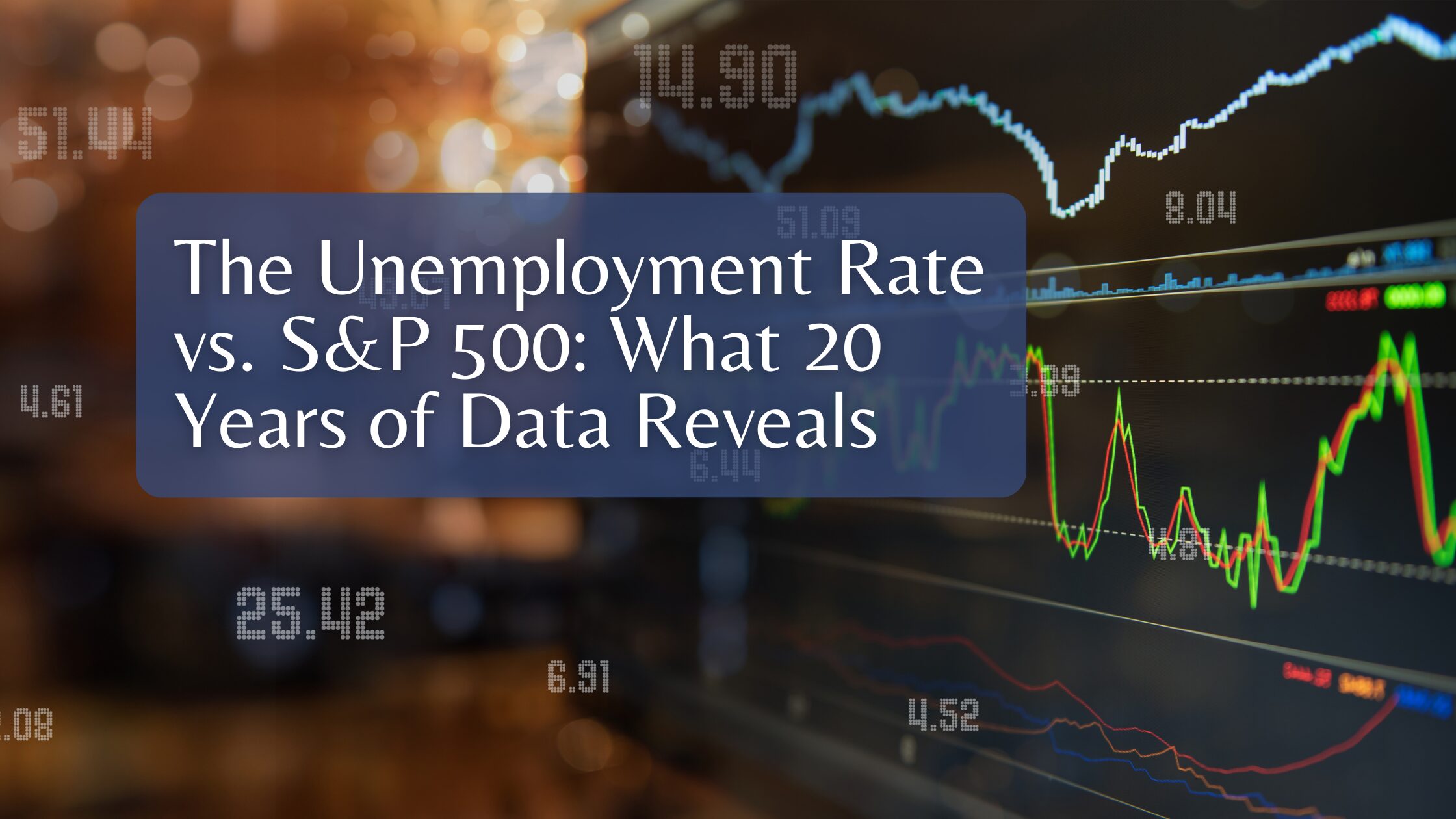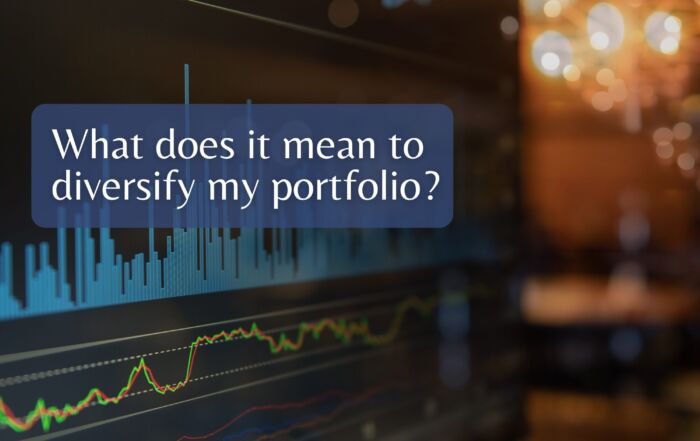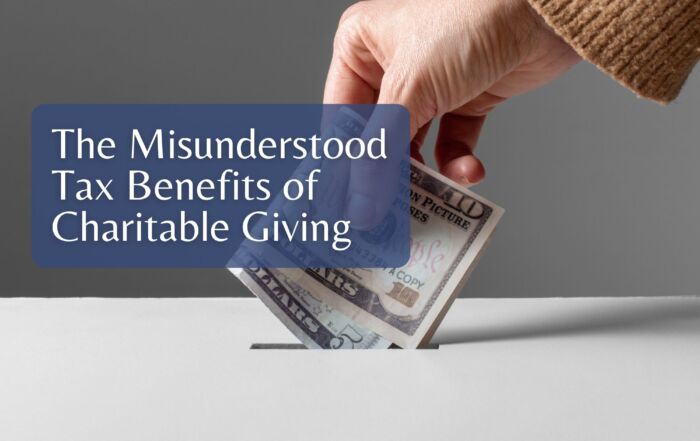The Unemployment Rate vs. S&P 500: What 20 Years of Data Reveals

Jobs and the Stock Market: Is There a Link?
When the economy booms or busts, we often see headlines about both the unemployment rate and the stock market. Intuitively, a strong job market (low unemployment) means people have income to spend, which is good for businesses and their stock prices. Conversely, high unemployment means less spending and lower corporate profits, potentially bad news for stocks. But how closely do these two indicators actually move together? The relationship has been complex over the past 20 years (2005–2025). This post explores how changes in U.S. unemployment have coincided with S&P 500 performance and whether unemployment can help predict future market trends.
2005-2025 Historical Trends
Over the long run, stock prices and unemployment tend to move in opposite directions. In other words, when unemployment rises during economic trouble, the S&P 500 often falls, and when unemployment falls in a recovery, the S&P 500 tends to increase. Looking at 2005–2025, this inverse correlation is striking during major economic swings:
2008–2009: The Great Recession
The U.S. unemployment rate jumped from about 5% in early 2008 to 10% by late 2009, its highest level in decades. During the same period, the S&P 500 plunged by about 37% in 2008 (and by early 2009 had lost over half its value from the 2007 peak). Stocks bottomed in March 2009 and began recovering even while unemployment was still climbing. By the end of 2009, the S&P 500 had bounced back +23% for the year, even though unemployment was still near 10%.
2010–2019: Recovery and Expansion
After 2009, unemployment gradually declined for a decade, from ~9–10% in 2010 down to just 3.5% by late 2019, a 50-year low. In that same span, the S&P 500 went on a historic bull run, roughly tripling in value from its 2009 lows. By 2014, as unemployment returned to pre-recession lows, the stock market was climbing to new highs. The inverse relationship was clear: a falling unemployment rate coincided with a rising stock market. Investors enjoyed strong average annual returns (e.g. +16% in 2012, +32% in 2013) as the jobless rate fell steadily.
2020: Pandemic Crash and Rally
This year tested the relationship like never before. In April 2020, the unemployment rate spiked to 14.8%, the highest since the Great Depression, virtually overnight due to COVID-19 lockdowns. The S&P 500 collapsed by over 30% in March 2020. Remarkably, stocks then rebounded quickly, even with unemployment extremely high. Trillions in stimulus and a “don’t fight the Fed” response powered a new bull market. By year-end 2020, the S&P 500 gained about +16% for the year, despite unemployment still around 6.7% in December. The market was looking past the dire immediate jobs picture toward an eventual recovery.
2021–2022: Recovery and Inflation
As the economy reopened, unemployment plunged from ~6% to 3.9% over 2021. Stocks surged too, the S&P 500 jumped nearly +27% in 2021. Normally, low unemployment is a positive sign. But 2022 proved an exception: unemployment stayed at an ultra-low 3.5–3.7% all year, yet the S&P 500 fell about –18%. In fact, for much of 2022, both unemployment and stocks were falling in tandem, breaking the usual inverse pattern. The culprit was surging inflation and rising interest rates, which hurt stocks even as the job market remained hot. This unusual episode reminded investors that other factors (like inflation and Fed policy) can outweigh the labor market’s positive signals.
2023–2025: Current Day
As of mid-2025, unemployment sits near 4.2%, still quite low, and the S&P 500 has recovered from the 2022 slump to reach new highs. Stocks rose in 2023 alongside a steady 3.5–3.8% unemployment range. However, the combination of very low unemployment and high inflation has made markets anxious about interest rate hikes. This shows that a low unemployment rate isn’t always bullish for stocks, it depends on the context. In general, though, the past 20 years confirm that recessions (with surging unemployment) have coincided with bear markets, and economic expansions (with falling unemployment) have accompanied bull markets.
Unemployment as a Lagging Indicator: Timing Matters
A key insight for investors is that the unemployment rate is a “lagging” economic indicator. It tends to reflect conditions that have already occurred in the broader economy, rather than predicting what’s next. Employers usually lay off workers after a downturn is underway, and only hire back once a recovery is well established.
History Bears This Out
In both the 2001 and 2008 recessions, unemployment kept rising for about a year after the recession officially ended. For example, the 2008–09 recession officially ended in June 2009, yet unemployment peaked months later in October 2009 at 10.0%. Similarly, after the early 2000s recession, joblessness didn’t top out until mid-2003. Stocks, however, usually hit bottom earlier. The S&P 500 often begins to recover before unemployment has peaked. Investors anticipate the rebound in economic activity even while the job market is still in rough shape.
This lag was evident in 2020 as well. The stock market recovery was already in full swing by summer 2020, while unemployment was still extremely high (over 10% in June 2020) and only gradually improving. The job market took longer to heal, finally nearing pre-pandemic low levels by late 2021, well after stocks had recovered.
Because of these timing differences, unemployment data on its own is not a timely predictor for the stock market. By the time the unemployment rate officially declines, the market may have already raced ahead. Conversely, when unemployment is at its absolute lowest point, the economic cycle may be nearing a top (with inflation or other issues brewing, as in 2022). In short, unemployment tends to confirm economic trends on a delay, it doesn’t necessarily foretell the next market move.
Does Low Unemployment Mean a Market Peak?
It’s easy to assume that low unemployment = a strong economy = good for stocks, and high unemployment = weak economy = bad for stocks. In general, that’s true directionally (as we saw in 2009 or 2020). However, extremes in either direction can send mixed signals for investors:
High Unemployment
In the depths of recessions, unemployment can be a contrarian indicator. By the time job losses mount and the headlines look bleak, the stock market may have already priced in a lot of bad news. Some of the best market gains often occur when unemployment is very high but starting to improve. For example, March 2009 (near the 9.0% unemployment mark) and April 2020 (unemployment 14.8%) were historically excellent times to buy stocks, precisely because things were so bad that they were likely to get “less bad” going forward. The S&P 500’s huge gains in the 6–12 months after those peaks in unemployment illustrate this point.
Low Unemployment
A low jobless rate reflects a healthy economy, which is generally positive for corporate earnings. Indeed, the long bull market of the 2010s coincided with steadily dropping unemployment. But once unemployment hits rock-bottom levels, it can also signal a late-cycle economy that risks overheating. By late 2019, unemployment was ~3.5%, wages were rising, and inflation pressures were building, factors that sometimes precede a market correction. In 2022, unemployment stayed ultra-low, yet stocks fell as the Federal Reserve hiked interest rates aggressively to fight inflation. The lesson is that context matters: low unemployment is a good sign, but if it sparks inflation and tighter monetary policy, stock investors may grow wary.
Can the Unemployment Rate Predict the S&P 500’s Future?
Correlation, not causation: Looking at 20 years of data, there is a clear inverse correlation between the unemployment rate and stock market trends over the broad business cycle. When one goes up, the other usually goes down. But importantly, this relationship doesn’t make unemployment a crystal ball for future stock performance. Several reasons why:
Markets are Forward-Looking
Stock prices reflect investors’ expectations about the future. If investors believe the economy will improve in the coming months, stocks can rise even while unemployment is still high. By the time unemployment numbers confirm improvement, the stock rally may have already happened. In statistical terms, studies show the contemporaneous correlation between unemployment and the stock market is actually quite low. The market often moves ahead of changes in the job data.
Lagging Turnarounds
Unemployment often peaks after a market bottom, and bottoms out after a market top. For example, stocks recovered in 2009 before unemployment peaked, and fell in 2022 even as unemployment hit 50-year lows. If one tried to time stock investments based purely on unemployment rate turning points, they would likely be late to the party. One analysis found that a strategy of investing only when unemployment is falling (below its moving average) outperformed waiting for it to rise. In other words, by the time unemployment “signals” improvement, the bigger market gains have often already occurred.
Other Factors at Play
Sometimes the unemployment rate sends a false sense of security or alarm. The 2022 case is instructive, unemployment was very low (positive), but inflation was very high (negative), and the Fed’s response to inflation dominated market direction. Likewise, in early 2008, unemployment was still relatively low (~5%), yet the stock market began to slump in anticipation of the housing crisis and recession ahead. Monetary policy, inflation, corporate earnings, and geopolitical events can all overwhelm whatever signal unemployment is giving at a given moment. Investors must consider the full mosaic of indicators.
Bottom line: The unemployment rate alone is not a reliable predictor for future S&P 500 returns. It is better viewed as a confirmation of economic conditions. A rising unemployment rate usually confirms a recessionary environment that likely has already hurt stocks. A falling rate confirms an expansion that has likely benefited stocks. But for forecasting purposes, unemployment data should be paired with leading indicators (like consumer confidence, yield curves, purchasing managers’ indexes, etc.) and watched in the context of inflation and Fed policy.
What It Means for Investors
For everyday investors, understanding the relationship between jobs and stocks can inform smarter decisions:
Don’t Wait for the News to Improve
By the time unemployment peaks, the stock market may already be rebounding. Some of the best investing opportunities arise when the outlook is darkest (high unemployment, recession fears), precisely because valuations are lower and a turn for the better isn’t priced in yet. If you wait for unemployment and other data to show full recovery, you might miss a significant part of the market upswing.
Stay Calm During Scary Spikes
Spiking unemployment often accompanies market crashes (2008, 2020). It’s tempting to sell in panic. But history shows that selling after unemployment surges means selling near market lows. Investors who held steady (or rebalanced into stocks) during those periods were rewarded when the economy and market recovered. Remember that unemployment is backward-looking, it tells you what has happened, not what will happen next.
Low Unemployment Is Good: But Watch for Overheating
A very low unemployment rate is generally positive, but it can coincide with rising inflation or asset bubbles. If the job market is too hot, central banks may step in to cool it (by raising interest rates), which can be a headwind for stocks. So while you can take comfort in a strong labor market, keep an eye on the bigger picture (inflation, interest rates, and corporate earnings). For example, in 2022, the low unemployment did not translate to stock gains because other forces took precedence.
Use Unemployment as a Big-Picture Gauge
For long-term investors, the unemployment trend can help identify where we are in the economic cycle. A rising trend in unemployment often aligns with economic downturns, a cue to be more cautious, ensure your portfolio is diversified, and perhaps look for value opportunities. A falling trend points to recovery, a time when taking on a bit more stock exposure (or staying invested) can pay off as companies’ profits improve. Just avoid overreacting to any one monthly jobs report. Instead, focus on the broader trend and other confirmation signals.
Remember Stocks Lead the Economy
The stock market usually anticipates changes in the economy. By the time it’s clear from unemployment data that the economy is strong, stocks may be expensive. By the time unemployment screams “crisis,” stocks may be on the verge of rebounding. That’s why a balanced, long-term strategy (with regular rebalancing) often beats trying to trade based on economic data releases. As the Nasdaq stock market put it, the unemployment report does impact investor sentiment and can cause short-term volatility, but it’s just one piece of the puzzle and should be weighed alongside other factors.
Key Takeaways for Investors
- Unemployment and the S&P 500 usually move in opposite directions over the economic cycle. In recessions, unemployment jumps and stocks fall; in expansions, unemployment falls and stocks rise. However, this relationship often has a time lag, with stock markets turning before unemployment does.
- The unemployment rate is a lagging indicator, not a crystal ball. It tends to confirm what the economy has been doing, it doesn’t reliably predict stock market turning points. Markets often rebound or decline ahead of major moves in unemployment.
- Context matters. Don’t view the jobless rate in isolation. Very low unemployment can coincide with market turbulence if it fuels inflation (e.g. 2022), and very high unemployment can coincide with market bottoms if investors expect improvement (e.g. 2009, 2020). Always consider interest rates, inflation, and earnings alongside employment data.
- For long-term investors, staying invested through the cycle pays off. Those who resisted the urge to sell during high-unemployment downturns were rewarded when the economy recovered. Conversely, chasing stocks only once the economy looks fully healthy can lead to buying at high prices. A better approach is regular investing (dollar-cost averaging) and rebalancing, using unemployment trends simply as one guide to the economy’s general health.
- Use unemployment as a temperature check, not a trading signal. A rising unemployment rate might warn you to review your risk exposure and prepare for volatility, while a falling rate is generally a green light that the economy is on the upswing. But no single metric can predict the market, so build a diversified strategy rather than trading solely on the latest jobs report.
What Do the Past 20 Years of Data Show Us?
The past 20 years show that the job market and stock market are indeed related. When millions of Americans are out of work, it’s usually a tough time for stocks, and when most people have jobs, businesses thrive and stocks tend to do well. However, the unemployment rate should be viewed as a rear-view mirror insight. It’s great for understanding the broader economic narrative and sentiment, but it’s not a timing tool for beating the market.
For retail investors, the big takeaway is to pay attention to employment trends as part of your macro awareness, but always invest with a holistic view. Stocks ultimately care about future earnings and interest rates as much as current unemployment. By keeping the unemployment-stock market relationship in perspective, you can make more informed (and less reactive) investment decisions in any economic climate.
Casey Smith
President, Wiser Wealth Management
Share This Story, Choose Your Platform!
Wiser Wealth Management, Inc (“Wiser Wealth”) is a registered investment adviser with the U.S. Securities and Exchange Commission (SEC). As a registered investment adviser, Wiser Wealth and its employees are subject to various rules, filings, and requirements. You can visit the SEC’s website here to obtain further information on our firm or investment adviser’s registration.
Wiser Wealth’s website provides general information regarding our business along with access to additional investment related information, various financial calculators, and external / third party links. Material presented on this website is believed to be from reliable sources and is meant for informational purposes only. Wiser Wealth does not endorse or accept responsibility for the content of any third-party website and is not affiliated with any third-party website or social media page. Wiser Wealth does not expressly or implicitly adopt or endorse any of the expressions, opinions or content posted by third party websites or on social media pages. While Wiser Wealth uses reasonable efforts to obtain information from sources it believes to be reliable, we make no representation that the information or opinions contained in our publications are accurate, reliable, or complete.
To the extent that you utilize any financial calculators or links in our website, you acknowledge and understand that the information provided to you should not be construed as personal investment advice from Wiser Wealth or any of its investment professionals. Advice provided by Wiser Wealth is given only within the context of our contractual agreement with the client. Wiser Wealth does not offer legal, accounting or tax advice. Consult your own attorney, accountant, and other professionals for these services.





